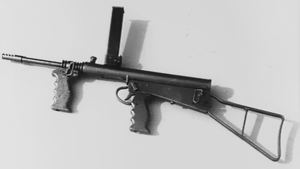Owen machine carbine
| Owen Gun | |
|---|---|

A photograph of the final design, completed Owen machine carbine gun
|
|
| Type | Submachine gun |
| Place of origin | Australia |
| Service history | |
| In service | 1942–1960s |
| Used by | See Users |
| Wars | |
| Production history | |
| Designer | Evelyn Owen |
| Designed | 1931–1939 |
| Manufacturer | Lysaght’s Works |
| Produced | 1942–1944 |
| No. built | c. 45,000 |
| Specifications | |
| Weight | 4.21 kg (9.28 lb) |
| Length | 806 mm (31.7 in) |
| Barrel length | 247 mm (9.72 in) |
|
|
|
| Cartridge | 9×19mm Parabellum |
| Action | blowback, open bolt |
| Rate of fire | 700 rounds/min |
| Muzzle velocity | 420 m/s (1,380 ft/s) |
| Effective firing range | 123 metres (135 yd) |
| Feed system | 33-round detachable magazine |
| Sights | Iron sights |
The Owen Gun, which was known officially as the Owen Machine Carbine, was an Australian submachine gun designed by Evelyn (Evo) Owen in 1939. The Owen was the only entirely Australian-designed and main service submachine gun of World War II and was used by the Australian Army from 1943 until the mid-1960s.
Owen, an inventor from Wollongong, was 24 years old in July 1939 when he demonstrated his prototype .22 calibre "Machine Carbine" to Australian Army ordnance officers at Victoria Barracks in Sydney. The gun was rejected for two reasons. The first was because the Australian army, at the time, did not recognise the value of submachine guns. The second was the basic construction of the prototype was completely unsuited as a military weapon, especially as it lacked a proper trigger or any safety device, was of small calibre, and the "magazine" was effectively a giant revolver cylinder which could not be exchanged to reload. Following the outbreak of war, Owen joined the Australian Army as a private.
In September 1940, Owen's neighbour, Vincent Wardell, discovered Owen's prototype in a sugar bag. Wardell was manager of a large steel products factory at Port Kembla. He showed it to Owen's father who was distressed at his son’s carelessness, but explained the history of the weapon. Wardell was impressed by the simplicity of Owen's design. Wardell arranged to have Owen transferred to the Army Inventions Board, to re-commence work on the gun. The army continued to view the weapon in a negative light, but the government took an increasingly favourable view.
The prototype was equipped with a "magazine" which consisted of a steel ring drilled with holes for .22 cartridges, and this was revolved through the action using the power of a gramophone spring. This arrangement later gave way to a top-mounted box magazine. This better allowed shooting while prone.
The choice of calibre took some time to be settled. As large quantities of Colt .45 ACP cartridges were available; it was decided to adopt the Owen Gun for it. Official trials were organised, and the John Lysaght factory made three versions in 9×19mm, .38-200 and .45 ACP. Sten and Thompson submachine guns were used as benchmarks. As part of the testing, all of the guns were immersed in mud and covered with sand to simulate the harshest environments in which they would be used. The Owen was the only gun that still operated after the treatment. Although the test showed the Owen's capability, the army could not decide on a calibre, and it was only after intervention from the higher levels of government that the army ordered the 9×19mm variant.
...
Wikipedia
